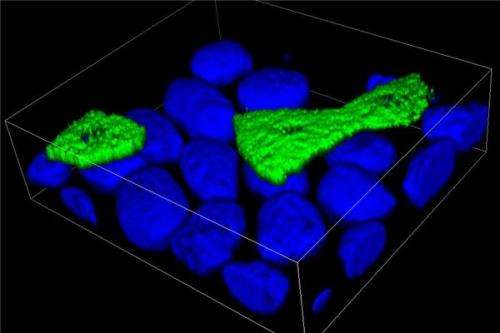Imaging the transport of substances in living cells reveals new sorting stations for proteins

The epithelium lines the organs of the human body. In the skin and the intestine as well as in the kidney, this cell layer forms a barrier that regulates the exchange of molecules like hormones and nutrients. The Freiburg biophysicist Dr. Roland Thünauer and junior professor Dr. Winfried Römer, Institute of Biology II and member of the Cluster of Excellence BIOSS Centre for Biological Signalling Studies of the University of Freiburg, have discovered a new mechanism by which proteins are transported to the outer membrane in epithelial cells.
These cells are polarized: The cell membrane facing outwards, known as the apical membrane, contains different proteins than the basolateral membrane, which faces the interior of organs. It is not well understood how proteins are transported to the appropriate cell pole via tiny membrane containers - so-called vesicles. Cells of an epithelium resemble a shipping port: Substances are delivered, shipped, produced, and sent.. Insights into the organization of the "cellular shipping port" can help to treat diseases in which this transport is impaired.
With the help of microscopy and the coordinated transport of fluorescent proteins in living cells, Thünauer and Römer tracked the path of a protein from its synthesis to its arrival at the apical cell membrane. In collaboration with researchers from Weill Cornell Medical College in New York, USA, and CBL GmbH in Linz, Austria, they uncovered new mechanisms and signaling molecules responsible for sorting proteins and transporting them to the apical membrane. The scientists published their findings in the journal Proceedings of the National Academy of Sciences (PNAS).
Cell membrane proteins are synthesized in the endoplasmic reticulum. They are then sent to the so-called Golgi apparatus and shipped from there to cell compartments or the cell membrane via small vesicles. The researchers discovered that proteins destined to the apical membrane are, after leaving the Golgi apparatus, also sorted at an additional compartment: the apical recycling endosomes (AREs). The protein Rab11 plays a key role in this process.. After leaving the AREs, the apical proteins are again packaged into vesicles and sent to the target membrane. The protein Rab11 is also involved in the final stage of their journey: The vesicles fuse with the outer membrane, allowing the proteins to reach the apical cell surface.
More information: Roland Thuenauer, Ya-Chu Hsu, Jose Maria Carvajal-Gonzalez, Sylvie Deborde, Jen-Zen Chuang, Winfried Römer, Alois Sonnleitner, Enrique Rodriguez-Boulan, and Ching-Hwa Sung. "Four-dimensional live imaging of apical biosynthetic trafficking reveals a post-Golgi sorting role of apical endosomal intermediates." PNAS. DOI: 10.1073/pnas.130416811
Journal information: Proceedings of the National Academy of Sciences
Provided by Albert Ludwigs University of Freiburg




















